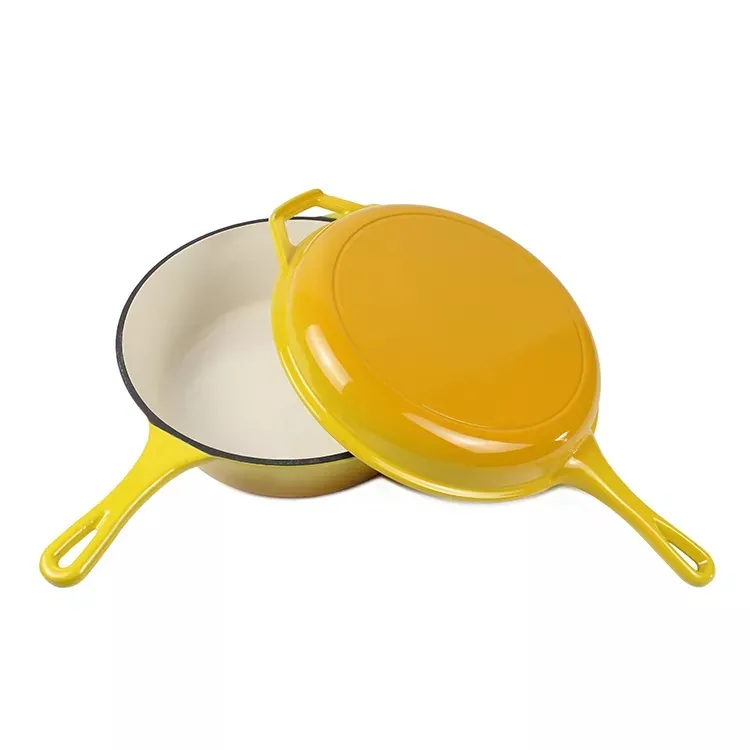Historical Roots of the Casserole Cast Iron Pot
The casserole cast iron pot is a culinary icon, bridging centuries of cooking traditions with modern haute cuisine. From its humble beginnings over open flames to its current status as a luxury kitchen staple, this versatile cookware has evolved alongside human innovation. This article traces the journey of the casserole cast iron dish, explores the rise of casserole enamel coatings, and examines how wholesale markets have transformed these tools from rustic essentials to high-end commodities.

Early Beginnings: The Birth of the Casserole Cast Iron Pot
The origins of the casserole cast iron dish date back to ancient China, where cast iron was first smelted around the 5th century BCE. Early iterations were heavy, rudimentary vessels used for slow-cooking stews over hearth fires. By the Middle Ages, European blacksmiths refined sand-casting techniques, creating thicker, more durable casserole cast iron pot ideal for communal cooking. These pots became fixtures in inns and households, prized for their ability to retain heat and withstand prolonged use.
Wholesale production of cast iron cookware began in the 17th century, with foundries in England and France supplying casserole cast iron pot to colonial markets. Their durability made them indispensable for long sea voyages, cementing their role in global culinary exchange.
Industrial Revolution: Mass Production and the Democratization of Casserole कास्ट आयरन Dish
The 19th-century Industrial Revolution revolutionized casserole cast iron dish manufacturing. Factories like America’s Griswold Manufacturing Company automated sand-casting processes, slashing costs and enabling mass production. By the 1870s, casserole cast iron pot were affordable staples in homes worldwide, sold wholesale to general stores and exported globally.
This era also saw the standardization of designs. The Dutch oven—a deep, lidded casserole cast iron pot—became a kitchen essential, used for baking, frying, and stewing. Wholesalers capitalized on its versatility, marketing it to railroads, military units, and frontier settlers.
The 20th Century: Innovation Meets Elegance in Casserole Enamel
The 1920s marked a turning point with the introduction of casserole enamel coatings. French company Le Creuset pioneered vitreous enamel—a glass-like finish fused to cast iron at high temperatures. This innovation addressed two key flaws of traditional casserole cast iron pot: reactivity with acidic foods and the need for laborious seasoning.
Casserole enamel cookware combined the heat retention of cast iron with a non-porous, colorful surface. Post-WWII economic booms fueled demand, and wholesalers began supplying hotels and restaurants with these durable, photogenic pots. By the 1970s, brands like Staub and Lodge entered the market, offering casserole enamel Dutch ovens in bulk to meet rising consumer and commercial demand.
Modern Luxury: The Casserole Cast Iron Dish as a Culinary Status Symbol
Today, the casserole cast iron dish transcends utility, embodying gourmet sophistication. High-end chefs and influencers tout casserole enamel cookware for its aesthetic appeal and precision cooking. Wholesale markets reflect this shift:
Premium Brands: Companies like Le Creuset and Finex partner with luxury retailers and professional kitchens, offering bulk orders of casserole enamel pots in custom colors.
Artisanal Revival: Small foundries produce hand-finished casserole cast iron pot, catering to boutique hotels and eco-conscious buyers.
Global Supply Chains: Wholesalers source raw iron from Brazil and China, while enamel pigments are sourced from Europe, creating a multinational production network.
The casserole enamel market alone is projected to exceed $2.5 billion by 2030, driven by demand from commercial kitchens and upscale home cooks.
Frequently Asked Questions About Casserole कास्ट आयरन Pot
How did the Industrial Revolution impact casserole cast iron pot availability?
Mechanized production lowered costs, making casserole cast iron pot accessible to the masses. Wholesalers distributed them globally, transforming them from luxury items to household staples.
Why is casserole enamel preferred over raw cast iron in commercial kitchens?
Casserole enamel resists rust and food reactivity, requires no seasoning, and offers a visually appealing finish—key for restaurants emphasizing presentation.
Are vintage casserole cast iron pot dishes as durable as modern versions?
Yes. Properly maintained vintage casserole cast iron pot can outperform modern ones, though they may lack the refined finish of contemporary casserole enamel.
How do wholesalers ensure quality in casserole enamel orders?
Reputable suppliers provide batch testing for chip resistance, heat tolerance, and lead-free certifications. Many offer warranties for commercial-grade casserole enamel cookware.
What drives the luxury pricing of high-end casserole cast iron pot?
Hand-finishing, premium casserole enamel coatings, and brand prestige justify costs. Wholesale buyers often prioritize durability and aesthetics for upscale clientele.
From ancient hearths to Michelin-starred kitchens, the casserole cast iron pot has endured as a testament to human ingenuity. Its evolution—from soot-covered casserole cast iron dish to gleaming casserole enamel centerpiece—mirrors broader shifts in technology, culture, and commerce. For wholesalers and chefs alike, this cookware remains a timeless bridge between tradition and innovation.
-
The Science of Enameled Cast Iron Baking PanसमाचारJun.09,2025
-
The Rise of the Big Cast Iron Griddle in Outdoor Cooking CultureसमाचारJun.09,2025
-
Multi-Use Magic of Cast Iron BBQ Grill PanसमाचारJun.09,2025
-
How a Meat Weight Press Enhances FlavorसमाचारJun.09,2025
-
Essential Accessories for Mastering Dutch Oven CampingसमाचारJun.09,2025
-
Why Ecast Iron Grills Are Heating Up Outdoor CookingसमाचारMay.23,2025
-
Why Cast Iron Cookware Belongs in Every Kitchen?समाचारMay.23,2025
